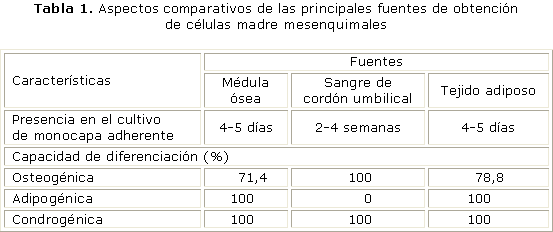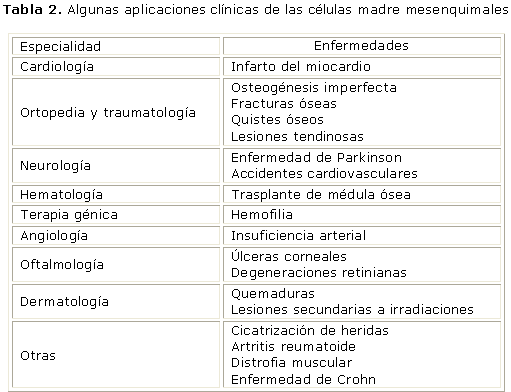Mesenchymal stem cells: relevant aspects and clinical application in regenerative medicine
Dr. Vianed Marsán-Súarez,I Dr. Miriam-Sánchez Segura,I Dra.C.M. Consuelo Macías-AbrahamI
SUMMARY
The most relevant aspects of mesenchymal stem cells are described, which include their plasticity towards various cellular lineages, such as chondrocytes, osteocytes, and adipocytes, among others. These cells can be obtained mainly from bone marrow, umbilical cord blood, and adipose tissue, from which cultures have been established that allow the study of their functional and phenotypic properties. They express CD73, CD90, and CD105 antigens in the absence of hematopoietic antigens CD34 and CD45, as well as different receptors for cytokines and adhesion molecules. Future research will allow us to understand various biological aspects of these cells, which are important in their use in regenerative medicine as a therapeutic measure to solve a wide variety of diseases.
INTRODUCTION
Mesenchymal stem cells (MSCs) are multipotent adult cells, with fibroblastoid morphology and plasticity towards various cell lineages such as chondrocytes, osteocytes and adipocytes, among others. They can be isolated and expanded in culture medium due to their properties of adhesion to plastic, differentiation and proliferation in vitro.1-10
Mesenchymal stem cells (MSCs) are characterized by presenting a spindle-shaped morphology with an elongated, central nucleus that contains 2 to 3 nucleoli. In flow cytometry studies, three subpopulations of these cells have been described. One of small, fusiform and agranular cells that they named RS-1; another of small and agranular cells named RS-2; and the last one, made up of large and granular cells that they called mature mesenchymal cells or MSCm. The presence of 2 morphological types in cultures has also been reported, one with a fibroblastoid shape, which is the predominant one, and another represented by larger cells with a rhomboid shape.1,11-16
MSCs can be isolated from different sources, including: bone marrow, umbilical cord blood, adipose tissue, pancreas, liver, skeletal muscle, dermis, synovial membrane, and dental pulp. Several published research groups have pointed out the possibility of also obtaining these cells from other alternative sources, such as amniotic fluid and Wharton’s jelly from the umbilical cord. However, the most commonly used tissues are bone marrow, umbilical cord blood, and adipose tissue.
Recent studies have indicated that there are no
There were no morphological or immunophenotypic differences between the cells obtained from these tissues, but the results indicated that although umbilical cord blood has a greater potential for expansion, its potential for differentiation is lower, as it does not differentiate into an adipogenic lineage.13-17
CHARACTERISTICS OF CMMS
Regarding the isolation and culture from adipose tissue, the cells obtained have a morphology, phenotype and differentiation capacity similar to bone marrow but with greater potential for proliferation. Obtaining samples of this tissue is minimally invasive and can be done through procedures such as liposuction or abdominoplasty.13,15 (Table 1).

In order for MSCs to be classified as such, they must express the mesenchymal antigens CD73, CD90 and CD105 and not have hematopoietic antigens such as CD34, CD45, CD14 and CD11b. In addition, it has been proposed that MSCs can express the following antigens: CD13, CD29, CD44, CD116, and platelet-derived growth factor receptor a.
On the other hand, it has been proven that MSCs are positive for other growth factors and cellular matrix such as: the receptor of the neuronal growth factor, the receptors of tumor necrosis factors I and II and the receptors of interleukins 1(CD121), 3(CD123), 4(CD124), 6(CD126) and 7(CD127). They express different adhesion molecules: ICAM-1 (CD54), ICAM-2 (CD102), ICAM-3 (CD50), VCAM (CD106), L selectin (CD62L), LFA-3 (CD58), ALCAM (CD66), NCAM (CD56), endoglin (CD 105) and CD 72. On the other hand, these cells are negative to cytochemical reactions: alkaline phosphatase, acid phosphatase and Sudan black.3,14-20
There are molecules of great relevance in hematopoiesis that are produced and secreted by MSCs. These molecules include components of the extracellular matrix such as collagens I, III, IV and VI, fibronectin, among others; and cytokines that include interleukin 6 (IL-6), leukemia inhibitory factor, macrophage colony-stimulating factor, fibroblast growth factor 1 (FGF-1) and 2 (FGF-2), vascular endothelial growth factor (VEGF), etc.17,18
MLM AND ITS IMMUNOMODULATORY EFFECTS
Due to the immunomodulatory capacity of these cells, they can prevent allogeneic rejection through different mechanisms. Numerous studies have shown that MSCs do not allow antigen recognition by interfering with the function of dendritic cells and T lymphocytes, so they have a local immunosuppressive effect due to their ability to secrete cytokines. This effect is enhanced when the cells are exposed to an environment with inflammatory activity or characterized by the presence of high levels of gamma interferon.19,21,22
In studies in vitro MSCs have been shown not to express class II major histocompatibility system antigens, indicating that they constitute a therapeutic potential in graft-versus-host disease because they can reduce or suppress induced immune reactions.19,23,24
In addition, they can affect the functioning of the immune system by other mechanisms. It has been indicated that MSCs can inhibit the proliferation of lymphocytes induced by alloantigens and mitogens such as phytohemagglutinin and concanavalin A, as well as their activation by anti CD3 and CD28 antibodies. It has also been pointed out that MSCs can inhibit the expression of molecules involved in antigen presentation and in co-culture with peripheral blood mononuclear cells, they increase the proportion of T lymphocyte subpopulations with a regulatory cell phenotype.25,26
It has been suggested that many of these effects are predominantly mediated by paracrine factors, as MSCs secrete a considerable number of immunomodulatory factors. It has also been suggested that immunosuppressive action could be linked to the involvement of other immunoregulatory systems.
As a complement to the above data, it can be noted that CMMs in vitro can inhibit the proliferation of T and B lymphocytes, support the development of regulatory T cells, decrease the lytic activity of natural cytotoxic or natural killer cells (in English, Natural Killer Cells) and cytotoxic T lymphocytes, inhibit the differentiation of monocytes into dendritic cells.27
CLINICAL APPLICATIONS OF MBCS
Due to the high multipotential capacity, plasticity and actions of MSCs, they are of great interest for clinical application (Table 2). Their characteristics allow them to be used to modulate immune reactions in autoimmune diseases and bone marrow transplantation; to regenerate destroyed or damaged tissues such as in neurodegenerative diseases, diabetes or heart disease. In addition, they could be used as a therapeutic vehicle for genes; for example, in monogenic diseases such as hemophilia.19,20

The clinical use of MSCs is based on a series of preclinical investigations in animal models, which have demonstrated the usefulness of these cells in the regeneration of organs and tissues, and have also been observed to modulate immune reactions in different diseases.19-22
In myocardial repair, different effects of MSCs on cardiac tissue are reported, such as their differentiation in situ in cardiomyocytes, in addition to the release of soluble factors and their fusion with cardiac cells. This application has been demonstrated in the porcine heart where a significant reduction in the size of the injured tissue, neovascularization and reduction of apoptosis levels have been observed.21,24
Another clinical application of MSCs is in bone repair. It has been proven in vivo In mice and dogs with craniofacial and long bone defects, the direct administration of these cells and their use on matrices such as hydroxyapatite/tricalcium phosphate have yielded satisfactory results. Recently, the possibility of using this procedure to optimize dental implants has been proposed. Currently, clinical trials in children with osteogenesis imperfecta have managed to obtain functional osteoblasts that increase the mineral content of the bone.20,23
In the field of ophthalmology, the use of MSCs is beginning to yield results in the treatment of corneal ulcers and retinal degenerations.
On the other hand, promising results have been obtained in the area of general surgery in the treatment of fistulas in different locations such as the respiratory and digestive tracts. In addition, important studies are being carried out in diabetes mellitus, neurodegenerative diseases and liver regeneration.1,19,24
With very positive results, these cells are used in burn victims, in skin lesions secondary to radiotherapy, where epithelial regeneration, angiogenesis, and significant histological hydration have been demonstrated. Different studies are being carried out for the use of MSCs in wound healing, either through systemic administration or by topical application at the wound site. Due to the exposed nature of the skin, the direct application of these cells in cases of polytraumatized individuals and severe burns is a very promising option. The use of MSCs in the treatment of chronic wounds has multiple objectives: to accelerate tissue repair, to cushion inflammatory events, and to reduce or eliminate scar formation.
Another alternative is to use MSCs to stimulate angiogenesis. Some studies have shown that these cells have a positive effect on the recovery of blood flow, which is explained by experimental evidence indicating the generation and incorporation of endothelial cells derived from MSCs, to the capillaries in their formation and by the results of recent studies that have shown that these cells also promote angiogenesis by the secretion of cytokines such as VEGF-A, FGF-2, and IL-6.17,20-

